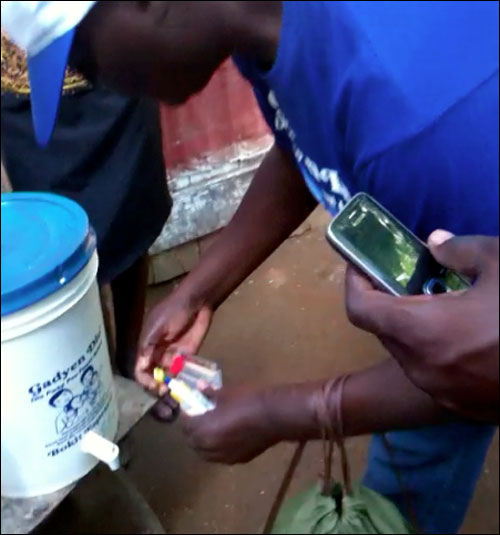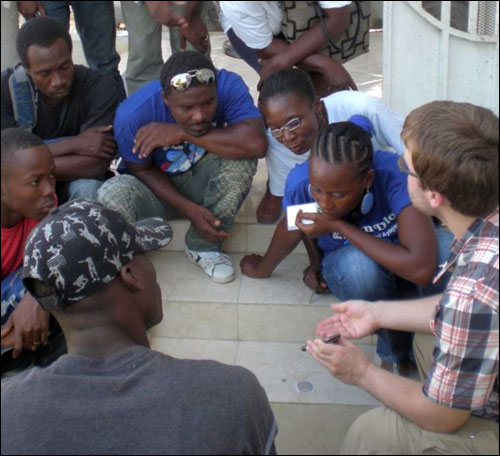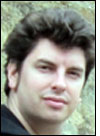Since 2007, Deep Springs International (DSI), a nonprofit organization based in Pennsylvania, has been providing water-treatment kits to Haitians. Each kit consists of a five-gallon plastic bucket with a lid and a spigot, as well as a chlorine solution and written instructions regarding how to use the kit.
As part of that program, DSI sends water technicians to the homes of those who use its kits, to check whether those households are utilizing them properly, and to provide additional chlorine solution, if necessary. To help it better manage its technicians and the data they generate, the organization has begun employing RFID technology—namely, Near Field Communication (NFC) passive 13.56 MHz RFID passive tags attached to buckets, as well as NFC-enabled phones to collect data and forward it to a back-end system.

The phones are being provided by Nokia Research Center (NRC), located in Palo Alto, Calif., with software developed by David Holstius, a student and Ph.D. candidate at the University of California, Berkeley‘s School of Public Health.
DSI contracts with Haitian companies to produce the buckets, which it then distributes free of charge to Haitian families, who can fill the buckets with water and add some chlorine solution to kill any pathogens that might be in it. (It takes approximately 30 minutes for one 7-milliliter [0.2-ounce] capful of solution added to 19 liters [5 gallons] of water to kill enough microbes to make that water potable.) DSI charges $1.25 per bottle of chlorine solution, says Michael Ritter, the company’s program manager in Haiti, with the proceeds from the chlorine sales helping to fund the employment of water technicians who regularly visit the homes in order to test the water to determine whether it is adequately chlorinated, and to sell more chlorine solution to any homes running low.
In 2009, Joseph “Jofish” Kaye, an NRC senior research scientist and ethnographer—while discussing projects using Nokia technology to improve the tracking of clean-water consumption with a colleague at the Centers for Disease Control and Prevention (CDC)—learned of DSI’s accomplishments in Haiti. DSI claims that its chlorine-based water-treatment system, known as Gadyen Dlo (Haitian Creole words meaning “water guardian”), has reduced the incidence of diarrhea among users by about 50 percent, by killing the pathogens that can make people sick. Since the country’s 2010 earthquake, as well as more recent cholera outbreak, the Gadyen Dlo system has gained the interest of multiple agencies, including the Haitian government.
Kaye learned that DSI’s water technicians had been recording their test results and chlorine sales manually on paper in three-ring binders, and were later submitting those reports to the organization’s staff in Port-au-Prince, to be entered manually into the back-end system. The process was slow for the technicians to fill out on paper, and for the office staff to key into the computer, and provided little proof that they were actually visiting each family. The visit results often came in after many days of collection, and were not always complete.
After proposing an NFC-enabled solution to Nokia’s Global University Fund, Kaye received $10,000 in funding to complete the project. He then met with Holstius to develop back-end software that could enable DSI to view and store information regarding the water technicians’ visits. The resulting software application, using the FrontlineSMS platform, manages data that technicians send in the form of text messages while completing water tests. Holstius also wrote a cell-phone software application that would prompt the technicians to answer specific questions about the water being tested. The prompts were originally written in French, but were also available in English and Creole.
In October 2010, the system went live with approximately 50 Nokia 6212 NFC-enabled phones, to be used by the technicians. Kaye also provided 22,000 ultrahigh-frequency (UHF) Gen 2 RFID tags from UPM RFID, of which UPM RFID donated the first 2,000 and sold the remainder to Nokia at cost. Holstius spent about one week in Haiti installing the software on DSI’s back-end system and on the phones, helping to train water technicians to utilize the system on the Nokia phones, and attaching an adhesive-backed tag to each bucket’s exterior.
Each water technician manages around 250 households, and is expected to visit most of them at least on a monthly basis. Upon arriving at a client’s home, a technician tests the water and then taps his or her phone against the water bucket’s NFC tag, thereby capturing that tag’s unique ID number. The technician then receives prompts on the phone, asking, “Did the water test positive for chlorine?” and “How much chlorine is left (in the household supply)?” as well as “How much chlorine did you sell?” When the technician responds to these prompts, that information is sent as an SMS text message to the FrontlineSMS software running on DSI’s back-end server. If there is no cellular connection, the phone stores the data until coming within range of a cellular tower.
The system currently includes 35,000 RFID-enabled buckets for drinking water, and Kaye says he has funding from Nokia to expand the program to another 100 phones. The long-term plan, he indicates, is to provide 200 phones.
To date, Ritter says, the system is working well. The data returned from technicians’ mobile phones indicates which households are being visited, the results of the water tests, and the quantity of chlorine being used. Unlike the manual paper method, the RFID solution provides that information reliably and in near real time, so that all details are provided and legible (as the handwritten paperwork might not have been). In the future, he hopes DSI can use this more reliable data for analytics to determine, for example, which families might not be using the chlorine properly, and might thus require further education in how to utilize the system, or more frequent visits from technicians.
“Really, we’re just now getting it all off the ground,” Ritter states. “What RFID adds is a way to verify visits were done, and hopefully be able to provide feedback to families and community health workers,” by alerting those families or communities that their chlorine use is incorrect. This would be based on analytics that he hopes DSI will be able to conduct with the data over the coming months. What’s more, because the RFID system saves technician labor time (since they no longer need to fill out paperwork), Ritter hopes to eventually increase the number of households that each technician manages.
Kaye says he would like to see the solution expanded to other parts of the world, where it could be used to monitor water testing or other health- or safety-related functions that are accomplished in remote locations. At present, he is seeking a grant from the Bill & Melinda Gates Foundation to expand the system.



